Just over a year ago, Particle (formerly Spark), makers of the very popular Core and Particle Photon WiFi development kits, released the first juicy tidbits for a very interesting piece of hardware. It was the Electron, a cheap, all-in-one cellular development kit with an even more interesting data plan. Particle would offer their own cellular service, allowing their tiny board to send or receive 1 Megabyte for $3.00 a month, without any contracts.
Thousands of people found this an interesting proposition and the Electron crowdfunding campaign took off like a rocket. Now, after a year of development and manufacturing, these tiny cellular boards are finally shipping out to backers and today the Electron officially launches.
Particle was kind enough to provide Hackaday with an Electron kit for a review. The short version of this review is the Electron is a great development platform, but Particle pulled off a small revolution in cellular communications and the Internet of Things
The Current State of Machine to Machine Cellular
Small microcontroller dev boards are nothing new. The technology to turn a hat, belt buckle, or bicycle into something that receives data from a cellphone tower has been around for more than a decade now, and a few very old blogs and forums preserved on archive.org reflect this fact. An old Siemens, Nokia, or Motorola phone, with the right serial cable,could be a microcontroller’s connection to the outside world.

More recently, Sparkfun and Adafruit have been putting together their own cellular modules for Arduinos and other similar boards. These modules, like SparkFun’s Cellular Shield, Adafruit’s FONA, and Seeed’s RePhone all provide easy-to-use cellular modules that plug into an Arduino. The problem is phone companies historically didn’t want to deal with a bunch of Arduinos blinking LEDs through their network.
While one would think more devices on a cellular network would be a good thing for a carrier, this is not what [Zach Supalla], CEO of Particle, found when creating the Electron. The success of a carrier in the eyes of shareholders depends on ARPU, average revenue per user, or the total revenue divided by the number of subscribers.
While the ARPU is great when AT&T, Sprint, and Verizon are selling multi-Gigabyte plans to smartphone users, it’s a terrible measure if a company is selling a lot of cheap one Megabyte plans. The economics of cellular carriers is why we don’t have a cellular Internet of Things; it doesn’t make sense for the carriers to do it.
Instead of going through the usual cellular carriers, Electron users will be getting their service directly through Particle. It’s a setup called a Mobile Virtual Network Operator, or MVNO, that allows carriers to work through Particle to provide plans without much data but at a very low price.
It’s a setup that works well for a cellular device that’s the size of a stick of gum. If you walk into your old Radio Shack, you will get blank stares (again!) if you ask about a low-cost plans that provide just a few Megabytes of data. Setting up a SIM card with Particle is as simple as entering a few digits into a webpage, entering your credit card info, and enjoying a Megabyte per month of data on a tiny microcontroller board.
The Hardware and Development Toolkit
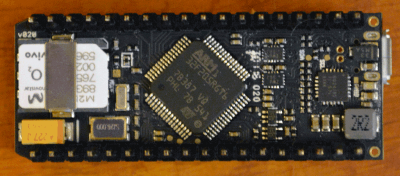 Particle already has a few hardware products under their belt, such as the Particle Photon and Core, a very popular ARM and WiFi development board. It’s incredibly useful for people who don’t want to futz around with bare ESP8266 modules. To anyone who has ever used a Photon or Core, the Electron will quickly become very familiar.
Particle already has a few hardware products under their belt, such as the Particle Photon and Core, a very popular ARM and WiFi development board. It’s incredibly useful for people who don’t want to futz around with bare ESP8266 modules. To anyone who has ever used a Photon or Core, the Electron will quickly become very familiar.
Tucked away on the bottom of the Electron is the STM32F205 microcontroller, presenting 36 total pins to the outside world. The functions presented on these pins include UART, SPI, I2C, and CAN bus. In total, there are 12 ADC channels, 3 UARTs, 2 SPIs, 1 I2C, 2 CAN, 2 DACs, and 13 PWM channels. 1 MB of Flash is included, and 128k of RAM is available. It’s an extremely capable board if you compare it to the Arduinos of a few years ago, and can go toe to toe with slightly more modern boards such as the Teensy 3.2.
The entire hardware design for the Electron is open source. Incidentally, Particle used Eagle to design the board.
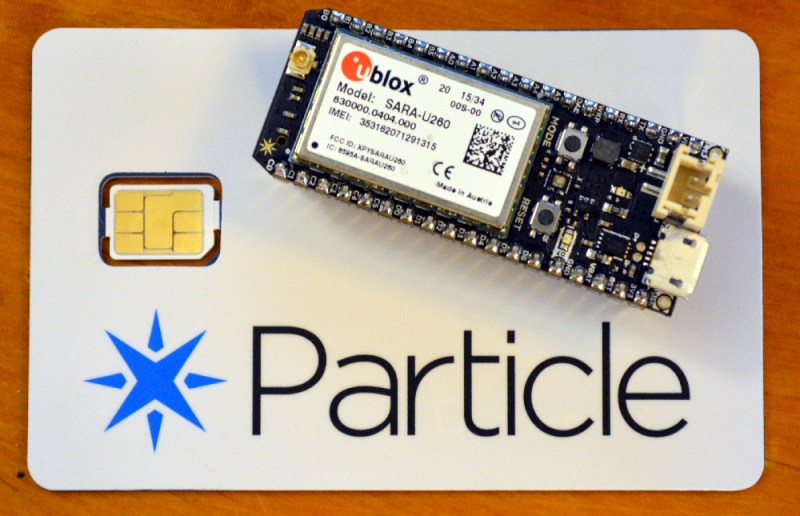
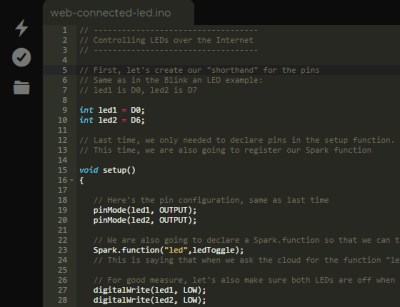
As for development for the Electron, choices abound. The easiest by far is a web-based Arduino-like development environment, Particle Build. Just like the Arduino IDE, Build will give you just enough to write some code and flash it to your device. Libraries for GPS modules, LCDs, switches, temperature sensors, and everything else that would normally be used in a one-off Internet connected project abound. While it’s not a full-blown IDE, it’s good enough and allows for over the air flashing of the Electron.
Particle’s Tinker app, a smartphone-based development environment is also available for the Electron. This app will allow you to read and write individual pins in a strange, ‘you know what’s cool? Visual programming’ way.
Javascript is possible on all of Particle’s devices, CLIs are easy, and if you’re coding for iDevices, your SDK is right here.
There are more than a few people who believe that a web-based IDE, especially one hosted on a server you don’t own, is a terrible idea. Lucky for us, Particle has made all their development tools open source, allowing anyone to roll their own personal cloud. For anyone concerned about the usefulness of Particle’s boards five or ten years down the line, this is a necessary feature.
The Future of the Electron and Particle Cellular
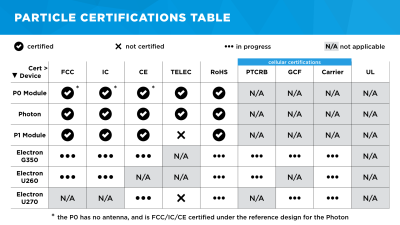
More than any other Internet of Things company, Particle is seeing a lot of their modules become the basis of real products. There’s a reason for this: they’re one of the few hardware developers that are sinking money into certifications. If you wanted to build a device with a Particle Photon inside it, the certifications are already taken care of. The FCC and cellular certifications for the Electron module are in the works, but [Zach] says that will happen.
Of course, any developer building a piece of hardware with Particle boards probably isn’t using a stock Photon or Electron. There’s no need for USB ports or pin headers when a board is stuffed inside a black box, anyway. For the smarts that go into a product, Particle already has a WiFi module, the P0 and P1, and [Zach Supalla] says Particle is considering a cellular module that would also be FCC and CE certified.
The Electron is a great piece of hardware, but it’s not the biggest development in the world of cellular-enabled hardware. That would be Particle’s MVNO and the no-contract, one Megabyte cellular plan that costs only a few bucks a month. The burning question on everyone’s mind is, ‘will Particle sell SIMs to people who want to roll their own hardware?’. The answer to this, at least for now, is yes. Even if you’re not interested in the Electron itself, the cheap cellular plan is undeniably interesting. It’s cheaper than other MVNOs like Ting, is designed to be a purely machine to machine plan, and it will be coming soon.
The Requisite 2G Warning
Particle is offering three version of the Electron. Two are for 3G networks – the U260-based board is for North America, the U270 is for Europe. The third version of the Electron is for 2G networks. The 2G version is $20 cheaper, but this may be a false economy. In the US, AT&T will begin shutting down 2G networks “soon” – either starting January 1, 2017, or whenever it doesn’t make economic sense to keep the 2G networks running.
Conclusion
Particle already has a lot of experience building Internet of Things things. The Core and Photon are excellent WiFi development boards with a strong development platform and a very capable cloud backend. The Electron is the continuation of this, expanding the Internet of Things to devices that move more than a few hundred meters when being used, or operate where WiFi networks aren’t available.
While the hardware is good, the big story here is Particle becoming a cellular network. Smartphones, as we know them today, have been around for nearly a decade and until now, no one – at least at a large carrier – has realized the value of giving a few kilobytes of data a month to tiny battery-powered devices. Somehow or another, Particle solved this problem, and they’re not locking it down to only their devices.
Particle will be shipping rewards out to Kickstarter backers beginning today, and the Electron (and SIM) will be available on the Particle website in due time.



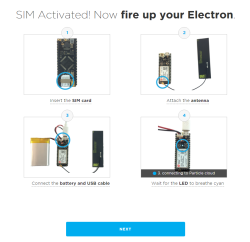


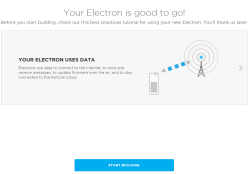















This has the potential of becoming a very disruptive technology. They may find themselves holding a tiger by the tail.
Why would it be, IEDs? I guess such use of this board will be easier to track than burner phone with prepaid card
It costs less for burner phones and sims, and $10 or less for a usb 3g modem that looks like a serial device so you can send/recv text messages and so on.
wait IED as in Improvised Explosives? I don’t really think that’s what DV82XL meant by “disruptive” I think he was using it in the tech world sense of shaking up the status quo, but even if he wasn’t I don’t understand how you jumped to IEDs. like honestly, I would be interested in the mental associations that you went through to end up there.
$3/month and you can SMS plenty of time/date/GPScoordinate info for 1MB. plus it’s tiny, would be good for tracking down stolen bikes, laptops, etc
I have both a plastic tiger from 1981 and a paper craft one I made in 1989 I held them by tails Gosh, they were fun to play with.
Paper-tigers are awesome!!!!
I have one coming, can’t wait to play around with it
Hope the Electron is easier to get working than the Photon has been {grumble}{grumble}.
After a week of struggle, I just gave up and Viper-ized my two Photons. But I still have 10 P1s that I need to find a use for (maybe geeky buttons for my coat?).
I’ll buy 1 or 2 off of you if you want! I don’t see the need to buy 10 of them but 1 or 2? sure!
Weren’t there a few other kickstarters for iot data sims too? Anyone have a list/comparison?
I have a ting sim that i use for GSM phones. I just noticed that you can get another one for 6$(or as many as you want for 6$ each). plus whatever txt or data you use. cheaper than the SIM that sparkfun offers from t-mobile. if you usage is very low. theirs is 10$ for a single sim for 6 months. and it you device is remote you have to go and replace it. Ting would allow you to have it and just pay a monthly cost.
See my comment below, but here’s ours: https://www.kickstarter.com/projects/konekt/konekt-dash-cellular-dev-kit-free-global-data-plan
Yessir – there is the Konekt Dash which offers similar functionality to the Electron
You can also use our Global SIMs in any hardware including the Electron. It is $1.00 for the first MB and $0.60 for every MB after that.
Konekt offers a worldwide 2G/3G IoT sim at $0.60/MB
RePhone from seeed, got one and it’s nice to play with.
great article, interesting development.
$39 + $3/month? No thanks… I’ll get an ESP8266 @ $2 and use Wi-Fi instead
Well, if you have easily available WIFI, then the Electron is clearly not the right choice. If you don’t, like say monitoring weather conditions at a cabin in the deep woods, or in a field 60 miles out of town, then that’s when something like the Electron or various other cellular boards becomes useful.
It’s all about using the right tool for the right job.
oh! wow! like. LONG-RANGE? No-one will have to create a global COMMUNICATIONS network of terrestrial stations technology?
you mean I don’t have to worry that no can invent and USE publicly available AMATEUR RADIO?
*hint read only the caps-lock text.
I know, right? It seems like HaD is neglecting HAM radio, which is basically free if you have a license, to appease some corporatesponsor that relies on (hackers like us) subsidizing their stupid broken network.
I think the missing period after the second paragraph says it all.
Didn’t have notifications on. I am a ham. I know you can use if for something like this, but it’s not always the right tool either.
Amateur Radio prohibits encryption or encyphering of data passed over the air. If you need to maintain the privacy of your data, this doesn’t work. Or if you need to control the system either. Now you could do secure, unencrypted communications with key signing, using your signing key to verify authenticity, but again, if you need privacy of commands or data sent to the remote system, you are again SOL with ham radio.
So get off your high horse!
Also, ham radio is only LONG-RANGE in the right conditions. With VHF/UHF, you’ve got line of site considerations. APRS can help with this, but that’s not guaranteed. Perhaps you meant HF? Well, then you need a larger antenna. And that may not work for every project. If you’re trying to make a small remote temp-sensor, you might not want to attach a big mag-loop antenna or big ass dipole to your project.
I don’t know why my comment about using the right tool for the right job brought up your HATE and soap-box RANT
*hint: my caps text is purely mocking. Please disregard.
Well, yeah, if you’re in range of a known wifi connection this would make very little sense, but that’s not the intended use. Think data coming from solar-powered sensors outside, or GPS coordinates from your bike if it’s stolen, or any number of other uses that don’t involve being near a friendly wireless access point.
Yes, or tracking company vehicles, say with coordinates sent only if the vehicle is moving.
Or pet dogs that have slipped away from their owners.
Or dolphin migrations.
Or spouse migrations.
Reminds me of my wife telling her friend about the justification for getting a carphone back in the day: “It’s like having a remote control for your husband.” The look on her husband’s face was priceless.
Gosh, I’ve never wanted to send someone back in time to WWII to work a Radio in a trench until now. I very much want to elect you to travel back in time now. Do you speak Navajo?
There are cheap gsm/gprs modules from China with serial connection for 1.7 USD also.
I can get one of these https://www.google.com/search?q=ZGPAX+S6&tbm=shop and a prepaid SIM with 1GB data that lasts a year for another USD $80
Look at the specs on that thing! 3G WiFi GPS….
I just need to get GP I/O lines via the USB interface, i.e. Add a Arduino Nano, which I could also run off the included battery.
That is a lot of options and functionality for under $200. And I bet if you ask around in Shenzhen somebody can get you just the main board for the watch for $20. So if people are going into the business of competing in that market they had better do a brilliant job in the areas of support, tutorials, project ideas, add-on and community.
Shameless plug
https://www.tindie.com/products/Fusion/tinytracker-gpsgsmcan-for-teensy-3132/?pt=full_prod_search
Is this device 2g or 3g?
2G for now, noone makes a 3G modem small enough for this application, but there may be new ones this year.
2G will not be supported soon by ATT… (i.e. most all 2G stuff ends up using ATT networks (i.e. resellers) so you might want move to 3G.
Pretty ambitious in scope for the cell plan– Only additional comment to piece would be, yes the 2G model could/would be a ‘white horse’ in the US, but I don’t believe there is a mention it is ‘global’. In my mind, this fact is a ‘really big deal’ as all of a sudden you *really* open up IoT in many much more potentially rural or remote areas for basic tasks/monitoring.
You only need one node with a long range link, the rest can use $2 WiFi modules as part of a mesh network to get data back to the main node. Even WiFi can be set up to create directional beams that operate over hundreds of kilometres.
If you do have GSM back to a phone tower the tower is going to have a microwave link back to more populated areas, in many cases.
Does this thing have coverage anywhere in the world or just when you’re connected to their tower? In Europe you can get gigabyte for around $6, depends on country and carrier, so $3 for a meg doesn’t seem like a good deal.
Depends on country. Cheapest italian carrier is 3 which offers 3Gb/5€ but it’s inconvenient to use as IoT because it stops you unles you load a page with a browser, then it redirects to internet.tre.it, after that it unlocks a 20Mb packet for 5-6h, after that you must unlock again. Other carriers often have silly rules which prevent robot uses like you must do some calls or risk sim blocking or telemarketers calling you and you get billed to be notified by SMS of the missed call.
You guys forgot about Konekt (disclosure: I’m an engineer there)
We have much better data pricing, have been doing IoT cellular for way longer, we have a board similar to theirs but it’s already shipping and we have an open cloud. Granted, we’re a little smaller and still building out features, but I think we have some cool stuff :)
Check out konekt.io for more info
https://hologram.io/
“Tagged 2g, 3g, cellular, crowdfunding, kickstarter, No I didn’t reference They Might Be Giants, particle, Particle Man, review, sim”
I’ll save you the effort:
[youtube https://www.youtube.com/watch?v=jAMRTGv82Zo&w=420&h=315%5D
That’s the one you weren’t refering to, isn’t it?
Is Gilgamesh like Sonny Bono or Ringo Star? Yeah, yeah, Gilgamesh that guy that collected all the the cursed Pre-Sumerian weapons including weapons wielded Abraxis blessed avatars before *cough*. Yeah. No. Sun meeting the Moon scares people for some dumb reason. Let’s agree to drop it because most Gen Y, Z? Won’t get it.
I have tens of IOT modules deployed using celular networks…
http://www.Mikroe.com sells various modules no bigger than this… expensive though 49.00 bucks.
i just use prepaid SIMs and happily IOT and SMS for pennies.
I was happy to see the backer shipment email–looking forward to playing around with this thing!
I forget where but I seen a WIFI/GPRS all-in-one proto board once. I’d rather get dataplans so I can transmit a lot of lat/long and serial to a central server.
I wish I could find a reference to a North America coverage map. Do they use the AT&T network for their backbone? Who else uses GSM in North America?
I think it’s just AT&T and a handful of regional carriers. I have yet to see a CDMA or LTE based kit that would work on a Verizon compatible networks. My home area network was all built by Cellcom, which is now a Verizon partner network. GSM connectivity is somewhat sparse outside of larger towns.
This tech is utter and complete landfill, crap and GARBAGE. Do you want “cleanskin” domestic cells? Because this is how you make cleanskin domestic cells.
In all sincerity you have zero clue about channel 0, the channel that the cell operators use to send YOU texts. That said, F’ AT&T and F Carrier IQ.
Gimme a CB or HAM operator with some cred and honor and I’ll show you a peace keeper.
Also consider a cheap android phone! With 35-50€ you get an efficient wi-fi to 3g router, just use built-in wi-fi tethering function. Then use an esp8266 as usual ;)
Can’t believe how much does data cost in the first world countries. In Ukraine 500MB cost just $2/mo.
I use onesimcard and only pay .05 per megabyte. It’s awesome.
I went to our local supermarket the other day and got phone for $10 that included a Telstra (Australia) SIM card with $10 credit – so with this I also get a battery/charger, case, keypad, camera and a display, plus the internal radio can rx FM radio. I am thinking it would be better to hack the cheap phone, it is not much bigger.
Yup, so long as you can tell people how to unlock and root the device and point to the correct set of build tools so they can strip all the bloatware off it and have room for the code they need. Once a phone gets that sort of treatment they get very popular :-) Or you can just treat it as a set of parts, but then you have the problem of interfacing them to a new MCU. I have a growing collection of old gear like that, lots of useful parts, if I can get the specs on them etc..
this has alot of potential
Just got mine a couple days ago. Will be playing with it this weekend.
Also backing this LoRa/Wifi/BLE one: https://www.kickstarter.com/projects/1795343078/lopy-the-lora-wifi-and-bluetooth-iot-development-p
The space once you get out of wifi range is an interesting, wide open one.
I just got mine and when setting it up I realized you can only flash via the cloud or command line. Seems a little weird since they have their own version of Atom, but it only has upload via cloud options…..